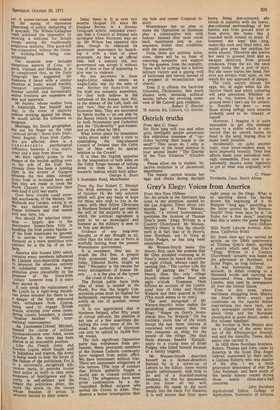Gray's Elegy: Voices from America
From Mrs Vera Oldham Sir: An article in the Spectator has come to my attention, quoted by the Los Angeles Times about two months ago. A Peter WatsonSmyth, "a retired businessman," questions the location of Thomas Gray's poem 'Elegy Written in a Country Churchyard.' Mr WatsonSmyth's theory is that the churchyard is in fact that of St Peter's, near Burnham, not St Giles at Stoke Podges, as has long been established.
Mr Watson-Smyth bases this theory, first, upon the premise that Mr Gray attended evensong at St Peter's, where he heard the curfew at eight o'clock, whence came the opening line, "The curfew tolls the knell of parting day," Was St Peters, then, the only village church whose curfew hour was eight o'clock Nonsense. Then follows an account of the Continental tour of Gray and Horace Walpole and their quarrel in 1740. (This much seems to be true.) The next paragraph of Mr Watson-Smyth's letter makes the astonishing statement that the Elegy "hinges on Grey's homo3exual love for Walpole." On the contrary, every line of the poem except the last three stanzas is concerned with exactly what the title connotes: an elegy for the people of the village. The final three stanzas, headed 'Epitaph,' apply to a young man of Stoke Podges, who killed himself because of a family tragedy.
Mr Watson-Smyth describes himself as a layman-detective. Instead, he is a stirrer-up of Letters to the Editor. Some retired people, unfortunately, with little to do and of a mischief-making tendency, do this for amusement, as you know all too well, probably. He needs to dig more deeply into the facts. For instance, it is well known that Grey spent eight years on the Elegy. What is so startling about his having shown the beginning of it to Walpole "long ago," according to the letter quoted by Mr WatsonSmyth? Grey even says he is "at Stoke for a few days," implying that this is where the poem begins.
Vera Oldham 3022 North Lincoln Avenue, Altadena, California 91001 Sir: Some time ago you carried an article, on the 200th anniversary of Thomas Gray's death, quoting a source which said that Gray's " Elegy Written in a Country Churchyard' actually was based on the graveyard at Burnham, not Stoke Poges, as long believed.
It was interesting that the account, in detail running to a thousand words and carrying an Associated Press dateline from London, was used by newspapers all over the United States.
Even in this town, where marijuana smuggling from Mexico (an hour's drive away) and conditions on the Apache Indian reservations (we have two), our daily newspaper carried the story about Gray and the Burnham churchyard in great detail. under a five column headline!
My brother in New Mexico sent me a clipping of the same story out of the Alburquerque Journal, and said the Amarillo, Texas. daily paper also carried it.
In 1635 three Burnham brothers, Robert, Thomas and John, came to America in the Good Ship Angel
Gabriel, supervised by their uncle. a Captain Roberts who was master
of the ship. I am a tenth generation descendant of that first John Burnham, and have much of the family history traced during those nearly three-and-a-half centuries.
John Burnham Agricultural Editor, College of Agriculture, University of Arizona,


































 Previous page
Previous page